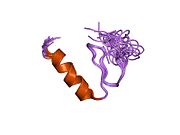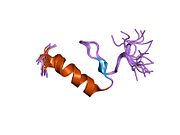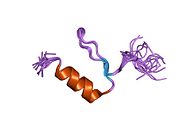Biology:KLF3
 Generic protein structure example |
Krüppel-like factor 3 is a protein that in humans is encoded by the KLF3 gene.
Structure
KLF3, originally termed Basic Krüppel-like Factor (BKLF), was the third member of the Krüppel-like factor family of zinc finger transcription factors to be discovered.[1] Transcription factors in this family bind DNA by virtue of 3 characteristic three C2H2 zinc fingers at their C-termini. Since their DNA-binding domains are highly conserved within the family, all KLF proteins recognize CACCC or CGCCC boxes of the general form NCR CRC CCN, (where N is any base and R is a purine).
Function
While the C-termini are similar in different KLFs, the N-termini vary and accordingly different KLFs can either activate or repress transcription or both. KLF3 appears to function predominantly as a repressor of transcription. It turns genes off. It does this by recruiting the C-terminal Binding Protein co-repressors CTBP1 and CTBP2.[2][3] CtBP docks onto a short motif (residues 61-65) in the N-terminus of KLF3, of the general form Proline – Isoleucine – Aspartate – Leucine – Serine (the PIDLS motif).[2][3] CtBP in turn recruits histone modifying enzymes to alter chromatin and repress gene expression.
KLF3 is expressed highly in the red blood cell or erythroid lineage. Here it is driven by another KLF, Erythroid KLF or KLF1, and its expression increases as erythroid cells mature. Studies in knockout mice reveal a mild anemia in the absence of functional KLF3 and the de-repression of several target genes that contain CACCC boxes in their regulatory regions.[4] Many of these genes are activated by KLF1, hence it appears that KLF3 operates in a negative feedback loop to balance the activating potential of KLF1. KLF3 also regulates another repressive KLF, KLF8.[5] Thus KLF1, KLF3 and KLF8 operate in a tight regulatory network. KLF3 and KLF8 may have redundant functions, as mice lacking both KLF3 and KLF8 show defects that are more severe than in either single knockout. They die in utero around day 14 of gestation.[6]
As well as being expressed in erythroid cells, KLF3 is present in other cell types and analysis of the knockout mice has revealed defects affecting adipose tissue[7] and B cells.[8] KLF3 deficient mice have less adipose tissue and indications of metabolic health that may be attributable to de-repression of the adipokine hormone gene adipolin.[9] The role of KLF3 in B lymphocytes is complex but it appears to operate in a network with KLF2 and KLF4 to influence the switch between spleen marginal zone and follicular B cells.[10]
Interactions
KLF3 has been shown to interact with:
References
- ↑ Crossley M (April 1996). "Isolation and Characterization of the cDNA Encoding BKLF/TEF-2, a Major CACCC-Box-Binding Protein in Erythroid Cells and Selected Other Cells". Mol. Cell. Biol. 16 (4): 1695–705. doi:10.1128/mcb.16.4.1695. PMID 8657145.
- ↑ 2.0 2.1 2.2 2.3 "The LIM protein FHL3 binds basic Krüppel-like factor/Krüppel-like factor 3 and its co-repressor C-terminal-binding protein 2". J. Biol. Chem. 278 (15): 12786–95. 2003. doi:10.1074/jbc.M300587200. PMID 12556451.
- ↑ 3.0 3.1 3.2 "Cloning and characterization of mCtBP2, a co-repressor that associates with basic Krüppel-like factor and other mammalian transcriptional regulators". EMBO J. 17 (17): 5129–40. 1998. doi:10.1093/emboj/17.17.5129. PMID 9724649.
- ↑ "The CACCC-binding protein KLF3/BKLF represses a subset of KLF1/EKLF target genes and is required for proper erythroid maturation in vivo". Mol. Cell. Biol. 32 (16): 3281–92. August 2012. doi:10.1128/MCB.00173-12. PMID 22711990. PMC 3434552. http://handle.unsw.edu.au/1959.4/53158.
- ↑ "A network of Krüppel-like Factors (Klfs). Klf8 is repressed by Klf3 and activated by Klf1 in vivo.". J. Biol. Chem. 283 (40): 26937–47. August 2008. doi:10.1074/jbc.M804831200. PMID 18687676.
- ↑ "Generation of Mice Deficient in both KLF3/BKLF and KLF8 Reveals a Genetic Interaction and a Role for These Factors in Embryonic Globin Gene Silencing". Mol. Cell. Biol. 33 (15): 2976–87. August 2013. doi:10.1128/MCB.00074-13. PMID 23716600. PMC 3719677. http://handle.unsw.edu.au/1959.4/53159.
- ↑ "Targeted disruption of the basic Kruppel-like factor gene (Klf3) reveals a role in adipogenesis". Mol Cell Biol 28 (12): 3967–78. Jun 2008. doi:10.1128/MCB.01942-07. PMID 18391014.
- ↑ "Impaired B cell development in the absence of Krüppel-like factor 3". J. Immunol. 187 (10): 5032–42. November 2011. doi:10.4049/jimmunol.1101450. PMID 22003205.
- ↑ "Loss of Kruppel-like Factor 3 (KLF3/BKLF) leads to upregulation of the insulin-sensitizing factor adipolin (FAM132A/CTRP12/C1qdc2)". Diabetes 62 (8): 2728–37. April 2013. doi:10.2337/db12-1745. PMID 23633521.
- ↑ "The mammalian zinc finger transcription factor Krüppel-like factor 3 (KLF3/BKLF)". IUBMB Life 63 (2): 86–93. February 2011. doi:10.1002/iub.422. PMID 21360637.
Further reading
- "Basic Krüppel-like factor functions within a network of interacting haematopoietic transcription factors". Int. J. Biochem. Cell Biol. 31 (10): 1169–74. 2000. doi:10.1016/S1357-2725(99)00067-9. PMID 10582345.
- "cDNA cloning, subcellular localization and tissue expression of a new human Krüppel-like transcription factor: human basic Krüppel-like factor (hBKLF)". Yi Chuan Xue Bao 30 (1): 1–9. 2003. PMID 12812068.
- "Role for SUMO modification in facilitating transcriptional repression by BKLF". Mol. Cell. Biol. 25 (4): 1549–59. 2005. doi:10.1128/MCB.25.4.1549-1559.2005. PMID 15684403.
- "Diversification of transcriptional modulation: large-scale identification and characterization of putative alternative promoters of human genes". Genome Res. 16 (1): 55–65. 2006. doi:10.1101/gr.4039406. PMID 16344560.
- "Global, in vivo, and site-specific phosphorylation dynamics in signaling networks". Cell 127 (3): 635–48. 2006. doi:10.1016/j.cell.2006.09.026. PMID 17081983.
External links
- KLF3 protein, human at the US National Library of Medicine Medical Subject Headings (MeSH)
 |




